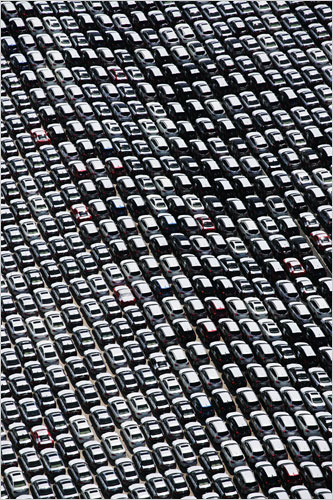Towards a 21st Century transportation policy

Imported cars are parked at Port Newark after being unloaded from container ships Monday, Sept. 8, 2008 in Newark, N.J. (AP Photo/Mark Lennihan)
Is an op-ed piece in today's Baltimore Sun by Kristi Horvath of the Maryland Public Interest Research Group. See "State's transportation policy is still stuck in the '50s." Yesterday's Sun featured a big piece on how transportation infrastructure expansion in Maryland is being delayed due to reductions in local and national gas tax revenues, "Drop in revenue forces cutback," and last week there was a big piece on toll road expansion through HOT lanes, "Driven away?" (Also see this letter to the editor about toll roads, "Toll lanes offer wrong solution."

Of course, long term lease of transportation infrastructure by states and localities is still big. Rates go up, but the government agency gets a big upfront payment. See "Leasing of Landmark Turnpike Puts State at Policy Crossroads" from the Wall Street Journal.
From the op-ed:
Currently, states receive highway funds based on outdated criteria in which more driving generates more in gas taxes and thus garners more federal dollars. It's a variation of the old rule that "no good deed goes unpunished": States that do their part to reduce America's oil dependence and global warming by promoting alternatives to driving lose out on federal money.
Instead of reducing transportation funding to states that are doing right, the federal government should reward states and localities that reduce gas consumption and miles driven by helping them more easily fund public transportation projects. Light rail, rapid bus transit, commuter rail, high-speed intercity rail and other forms of public transit are energy efficient, encourage development patterns that require less driving, and help cut pollution that leads to global warming.
A recent report by the Maryland Public Interest Research Group shows that public transit around the country saved 3.4 billion gallons of oil in 2006 and prevented 26 million tons of greenhouse gases. Americans are eager for better public transit options. In fact, 53 percent of Americans tell pollsters they would like to take more public transportation if it were available near where they live and work.
Giving citizens the transportation choices they want will require Congress to make changes. Since 1956, federal, state and local governments have spent nine times more on highways than on public transportation. This ratio has improved in recent years, but not fast enough. And President Bush proposes to take us back in time by cutting transit money, slashing Amtrak's budget and raiding the transit trust fund to make up for the shortage in the highway fund. Such cuts would move the country in exactly the wrong direction.
The MPIRG report: Squandering the Stimulus: An Analysis of Household Gas Spending, Economic Stimulus Checks, and the Need for Better Transportation Options
Labels: transportation planning



0 Comments:
Post a Comment
<< Home